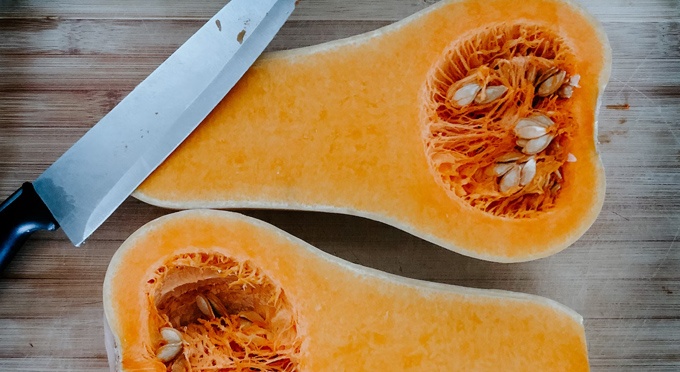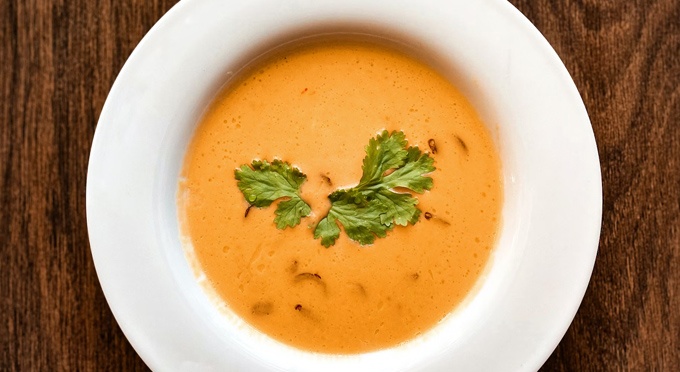
If you look around, you’ll find lots of tips and advice for working with butternut squash because it’s a versatile ingredient that can be used to prepare a wide range of side dishes and entrees. With such a wide range of uses, and with so many options for cooking, it can be tough to know which way is best when preparing a dish with this popular gourd. It’s use goes way back to 5500 BC, and there has been quite a bit of experimentation over time, so you’ll find a variety of recipes, tips and options if you look. To skip the search, and quickly learn about the most important aspects of cooking and eating butternut squash, just continue reading below.
What Is Butternut Squash?
Butternut squash is a type of winter squash known for its sweet, nutty flavor and vibrant orange flesh. It belongs to the gourd family, which includes other squashes and pumpkins. Butternut squash is a popular vegetable in many culinary traditions and is used in a variety of dishes due to its versatile nature.
Key characteristics of butternut squash include:
- Shape: Butternut squash typically has a pear or bell shape, with a thick neck and a bulbous bottom.
- Color: The skin of butternut squash is tan or beige, while the flesh is a rich, deep orange.
- Flavor: It has a sweet and slightly nutty taste, making it a favorite for both savory and sweet recipes.
- Texture: When cooked, butternut squash becomes tender and smooth, making it ideal for purees, soups, and mashes.
Butternut squash is a nutritious vegetable and a good source of vitamins, minerals, and dietary fiber. It provides essential nutrients like vitamin A, vitamin C, potassium, and folate, making it a healthy addition to your diet. It’s often used in dishes like roasted butternut squash, butternut squash soup, casseroles, and even in desserts like butternut squash pie or muffins.
Due to its natural sweetness, butternut squash can be enjoyed in various ways, either as a side dish or as the star ingredient in a main course. It’s especially popular in the fall and winter months when it’s in season, and its comforting flavor and vibrant color make it a staple in many holiday recipes.
Choose The Best One and Store It Properly
Shopping for and storing butternut squash is relatively easy, and with proper care, you can enjoy this nutritious and versatile vegetable for an extended period. Here’s how to shop for and store butternut squash:
Shopping for Butternut Squash:
Choose a Healthy Squash: When selecting butternut squash, look for one that is firm, heavy for its size, and free of soft spots, blemishes, or mold. The skin should be dull and matte, not shiny.
Check the Stem: Ensure that the stem or the top of the squash is intact. A damaged or missing stem can indicate that the squash is not fresh or may have been mishandled.
Size Matters: While butternut squash comes in various sizes, choose one that suits your needs. Smaller ones are often easier to handle and cook quickly, while larger ones are great for making larger quantities of dishes or for storing longer.
Storing Butternut Squash:
Store at Room Temperature: Whole butternut squash can be stored at room temperature in a cool, dry place. A pantry, cellar, or kitchen counter works well. Ensure good air circulation around the squash.
Avoid Direct Sunlight: Keep the squash away from direct sunlight, as prolonged exposure can cause it to ripen and deteriorate more quickly.
Use a Basket or Tray: Place the squash on a basket or tray rather than directly on a surface to allow for better air circulation and prevent moisture buildup.
Check Regularly: Periodically inspect your stored butternut squash for any signs of decay or softening. If you notice any issues, it’s best to use or cook the squash promptly.
Store Separately: Keep butternut squash away from other fruits and vegetables, especially those that emit ethylene gas (e.g., apples, bananas), as this gas can accelerate the ripening process and spoil the squash.
Consider Temperature: If you live in a very warm climate, it might be better to store butternut squash in a cooler location to extend its shelf life.
Using Stored Butternut Squash:
Prioritize Freshness: Use the squash within 1-3 months of purchase or harvest for the best flavor and texture. Smaller squash may have a shorter storage life.
Handle with Care: When you’re ready to use the stored squash, handle it gently to avoid bruising or damaging the skin.
Cut and Use as Needed: Once you cut into a butternut squash, it’s best to use it relatively quickly. You can refrigerate cut squash in an airtight container for a few days.
Freezing Option: If you have an excess of butternut squash or want to store it for longer periods, consider peeling, cubing, and blanching it before freezing in airtight containers or freezer bags. Frozen butternut squash can be used in soups, stews, and other dishes later on.
By following these guidelines, you can enjoy the flavor and nutrition of butternut squash over an extended period while minimizing waste and ensuring it stays fresh and delicious.
How To Prepare and Cook It
Prepping and cooking butternut squash can be a rewarding culinary experience. This versatile vegetable can be used in a variety of dishes, from soups and side dishes to salads and even desserts. Here’s the best way to prep and cook butternut squash:
Prep Tips:
Choose the Right Squash: Start by selecting a fresh, firm butternut squash. Look for one with smooth, unblemished skin and a matte appearance.
Wash and Dry: Rinse the squash under cold water and pat it dry with a clean kitchen towel.
Cut Off the Ends: Using a sharp chef’s knife, carefully trim off both ends of the squash.
Peel the Squash: Using a vegetable peeler or a sharp knife, peel the skin off the squash. The skin is usually tough and not enjoyable to eat, so it’s essential to remove it.
Cut in Half Lengthwise: Once the squash is peeled, cut it in half lengthwise. You’ll now have two long halves.
Scoop Out Seeds: Use a spoon to scoop out the seeds and the stringy pulp from each half. You can save the seeds for roasting if you like.
Cut into Desired Shapes: Depending on your recipe, you can cut the squash into cubes, slices, or any other shape you prefer. Cubes are versatile and work well for roasting or for soups.
Cooking Methods:
Roasting:
- Toss the butternut squash cubes with olive oil, salt, pepper, and your choice of seasonings (e.g., rosemary, thyme, garlic).
- Spread them evenly on a baking sheet.
- Roast in a preheated oven at 400°F (200°C) for about 25-35 minutes, or until the squash is tender and slightly caramelized.
Boiling or Steaming:
- Cut the squash into smaller pieces and place them in a pot.
- Cover with water and add a pinch of salt.
- Bring to a boil and simmer until the squash is tender, typically 10-15 minutes.
- Drain and use as needed.
Sautéing:
- Cut the squash into small cubes or slices.
- Heat a skillet or pan over medium heat and add a bit of oil or butter.
- Add the squash and sauté until it’s tender and lightly browned, stirring occasionally. This method is quick and works well for side dishes.
Mashing:
- Boil or steam the squash until it’s very soft.
- Mash it with a potato masher or blend it with a hand blender.
- Season with butter, salt, and pepper for a simple mashed butternut squash dish.
Soup:
- Cook the squash (cubed) with onions and garlic in a large pot until tender.
- Add vegetable or chicken broth and simmer until everything is soft.
- Blend the mixture until smooth to create a creamy butternut squash soup.
Remember that the cooking time may vary depending on the size and thickness of the squash pieces. It’s a good idea to check for doneness with a fork; the squash should be tender but not mushy.
Enjoy your cooked butternut squash as a side dish, in salads, as a soup, or in various other culinary creations. Its sweet and nutty flavor pairs well with a variety of seasonings and ingredients.

Homemade Butternut Squash Soup Recipe
One of the best things you can make with butternut squash is a delicious and creamy Butternut Squash Soup. This comforting and flavorful soup is perfect for chilly days. Here’s a simple recipe:
Ingredients:
- 1 medium butternut squash (about 2-3 pounds), peeled, seeded, and diced
- 1 medium onion, chopped
- 2 cloves garlic, minced
- 2 carrots, peeled and chopped
- 2 celery stalks, chopped
- 4 cups vegetable or chicken broth
- 1 teaspoon ground cumin
- 1/2 teaspoon ground cinnamon
- 1/4 teaspoon ground nutmeg
- Salt and pepper to taste
- 2 tablespoons olive oil
- 1/2 cup heavy cream or coconut milk (for a dairy-free option)
- Optional garnishes: toasted pumpkin seeds, croutons, fresh herbs, or a drizzle of cream
Instructions:
Prepare the Squash:
- Peel the butternut squash using a vegetable peeler.
- Cut the squash in half lengthwise and scoop out the seeds and stringy pulp using a spoon.
- Dice the squash into small, evenly sized cubes.
Sauté the Vegetables:
- In a large pot or Dutch oven, heat the olive oil over medium heat.
- Add the chopped onion, garlic, carrots, and celery. Sauté for about 5-7 minutes until the vegetables begin to soften and the onions turn translucent.
Add the Squash and Spices:
- Add the diced butternut squash to the pot.
- Sprinkle in the ground cumin, ground cinnamon, ground nutmeg, salt, and pepper. Stir to coat the vegetables with the spices.
Simmer with Broth:
- Pour in the vegetable or chicken broth to cover the vegetables.
- Bring the mixture to a boil, then reduce the heat to low and let it simmer for about 20-25 minutes, or until the squash and other vegetables are tender.
Blend the Soup:
- Use an immersion blender to carefully blend the soup until it’s smooth and creamy. Alternatively, you can transfer the soup in batches to a blender, but be cautious when blending hot liquids.
- Return the blended soup to the pot.
Finish with Cream:
- Stir in the heavy cream or coconut milk to add creaminess to the soup. Adjust the amount to achieve your desired consistency.
- Taste the soup and adjust the seasonings with more salt and pepper if needed.
Serve:
- Ladle the hot butternut squash soup into bowls.
- Garnish with your choice of toasted pumpkin seeds, croutons, fresh herbs, or a drizzle of cream.
This Butternut Squash Soup is both hearty and comforting, making it an ideal appetizer or a satisfying meal when paired with some crusty bread. Enjoy the rich and warming flavors of this classic autumn dish.
Have your own favorite recipe? Use the comments section below to share with everyone else.
Got your own tips on how to shop for, prep, or cook butternut squash? We would love to hear about any other tips, tricks or advice when working with this popular food.